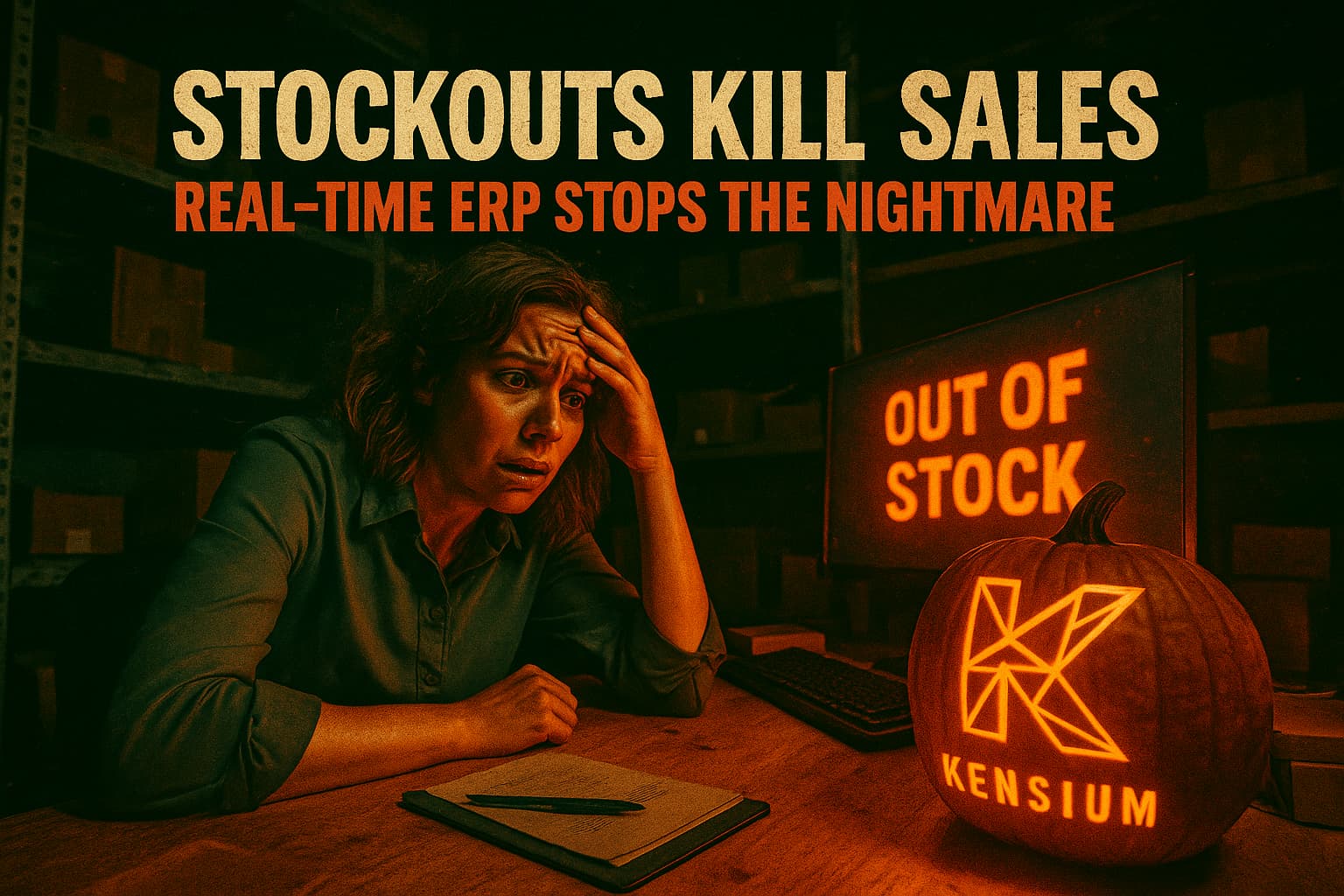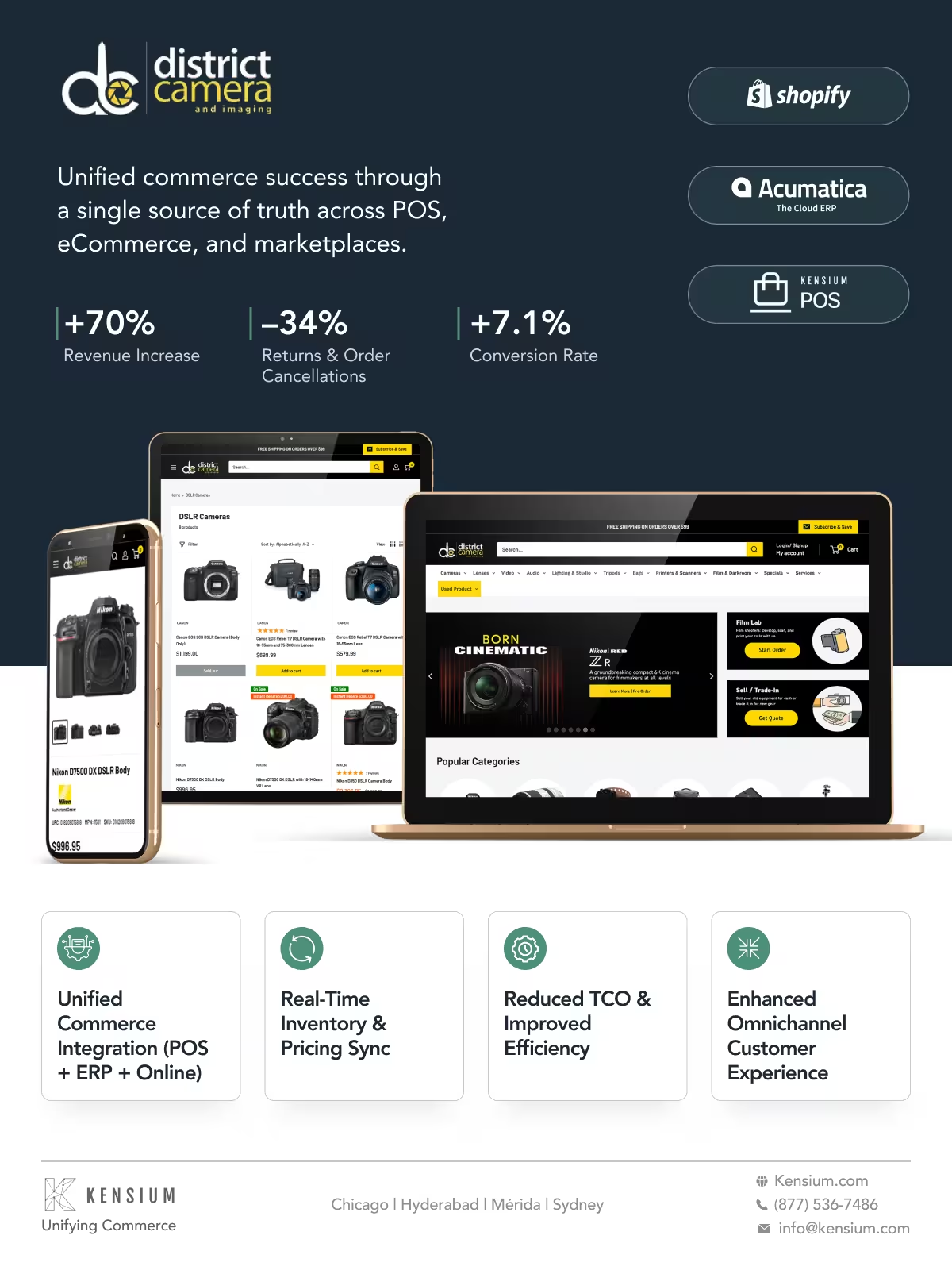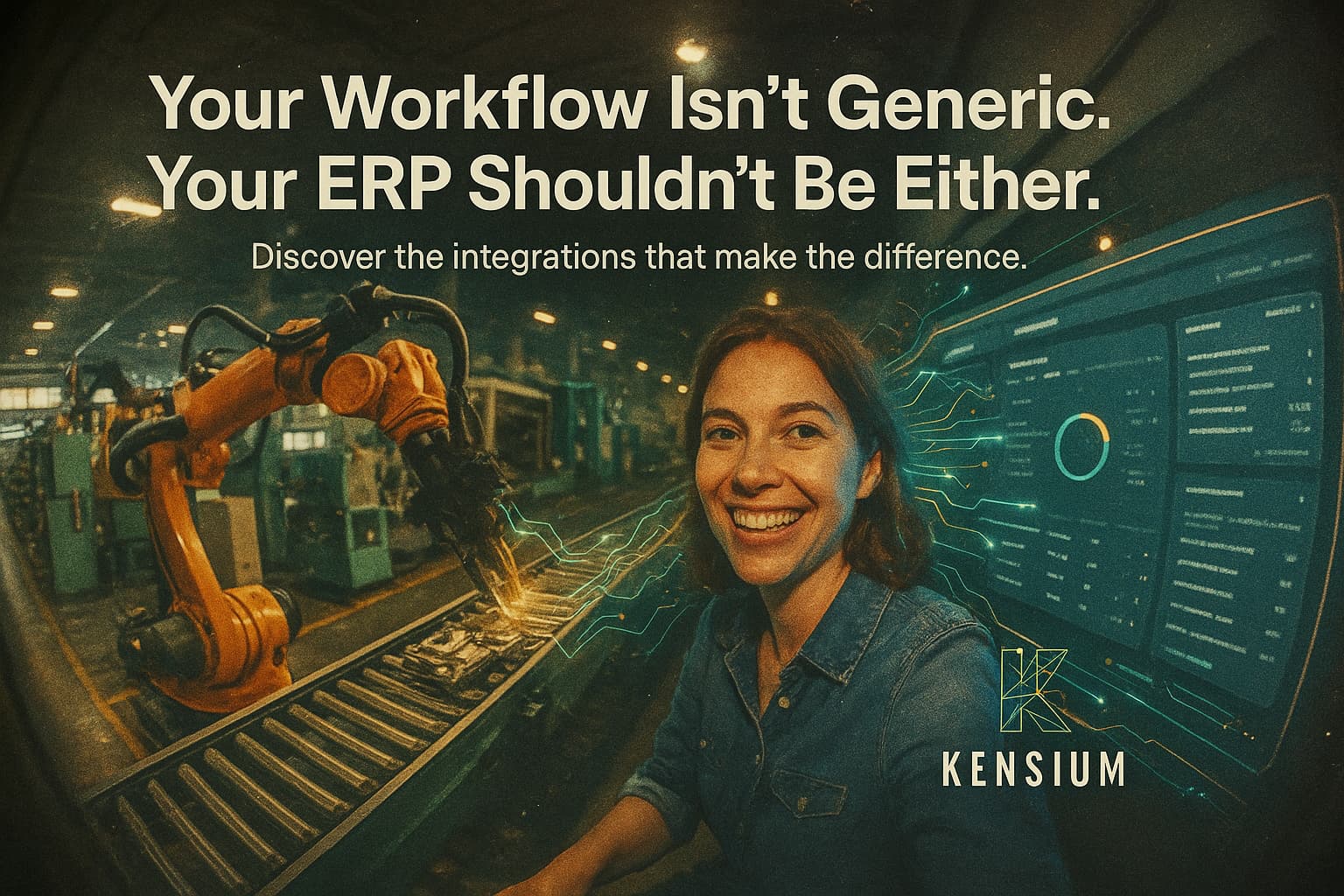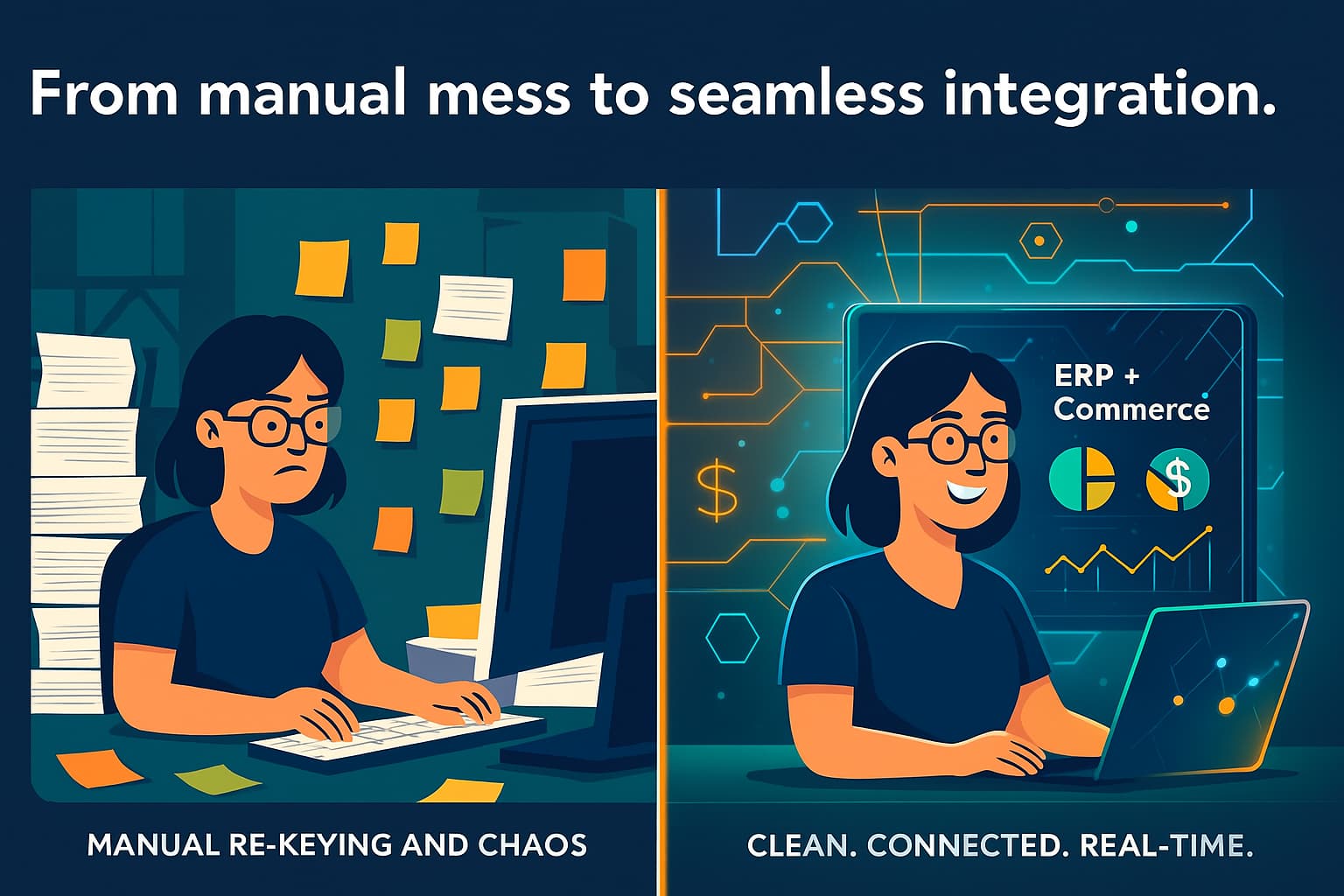
Retailers know that few things are as painful as telling a customer an item is out of stock right after they’ve placed an order. Stockouts and overselling aren’t just minor hiccups – they’re costly nightmares. In fact, inventory stockouts and overselling cost retailers an estimated $1 trillion each year in lost sales and damaged customer loyalty[1]. These issues often stem from inconsistent inventory data across sales channels. Without real-time inventory updates, a retailer can accidentally sell more items than they actually have on hand, forcing them to cancel orders and disappoint customers. As Shopify’s own retail guide warns, “A lack of real-time inventory updates can lead to overselling”[1]. To avoid this fate, modern retailers are turning to ERP integration – connecting their e-commerce sites, point-of-sale systems, and marketplaces with a centralized Enterprise Resource Planning (ERP) system – to keep inventory perfectly in sync. This article explores how real-time ERP integration saves retailers from out-of-stock nightmares, and how Kensium’s solutions make unified inventory a reality across in-store and online channels.
“Inventory stockouts and overselling cost retailers $1 trillion each year.”
The High Cost of Stockouts and Overselling
When a customer orders a product that isn’t actually available, the fallout can be severe. You not only lose the immediate sale, but also risk losing the customer’s trust (and future business) to a competitor. Multiple studies underline the impact: one Harvard Business Review piece notes stockouts result in more than lost sales; they also drive negative customer experiences[2]. Shoppers may tolerate one stockout, but after repeated issues many will switch brands entirely. In practical terms, overselling often forces retailers to scramble with apologies, refunds, or rush shipping of backorders – all of which erode profit margins and goodwill.
To understand the nightmare scenario, consider a real merchant’s Black Friday horror story when their inventory wasn’t syncing fast enough between systems:
“Last Black Friday was a nightmare with overselling products because Shopify's inventory didn't sync fast enough with other channels... the sync delay meant we oversold by 30 units on Shopify alone. Spent the entire weekend calling customers to cancel orders. Lost probably 15k in sales plus damaged reputation from angry customers.”[3]
Nightmare: When your systems don’t sync, customers pay the price.
This kind of incident highlights how data delays and siloed systems lead directly to lost revenue and public relations headaches. Even smaller-scale stockout issues can pile up – overselling by just a few units means disappointing those customers and likely losing them to a competitor. The bottom line is clear: selling an item that isn’t actually in stock is one of the fastest ways to hurt your business. It’s no wonder retailers call these situations an inventory nightmare.
Why Real-Time Inventory Data Matters
How do these nightmares happen in the first place? Often, it’s because inventory counts aren’t being updated in real time across all the places you sell. If your point-of-sale (POS) in a brick-and-mortar store, your online eCommerce site, and your marketplace listings (Amazon, eBay, etc.) are all tracking stock separately (or on a time delay), it’s easy for one channel to sell an item that another channel just sold a minute ago. In other words, fragmented or slow inventory systems = overselling risk.
Consistency and speed of data are key. As one retail expert put it, without integration “inventory is difficult to keep in sync and there are possibilities of overselling or running out of popular products”[4]. If multiple channels draw from the same warehouse without rapid updates, two customers on different platforms might buy the last unit simultaneously, with only one order actually fulfillable[5]. The result? One customer goes unfulfilled, and your team scrambles to fix the mess.
Real-time inventory data prevents these scenarios by ensuring that the moment a sale happens anywhere, every other channel knows about it. When your systems are integrated, a purchase at your physical store will instantly decrement the available stock on your website, and vice versa. This immediacy is crucial during high-volume events or flash sales. For example, Shopify’s retail experts note that a connected inventory system lets customers shop in-store or online without confusion because all sales channels and inventory are tied together[6]. Without that, the first warning you get about an inventory discrepancy might be an angry customer email.
Beyond preventing oversells, real-time data means your customers see accurate, up-to-date stock levels when browsing your online store. Nothing frustrates an online shopper more than ordering an item that appears available, only to get an “oops, we’re actually out of stock” message later. By contrast, a real-time integrated system will update your site to mark products as “sold out” or low in stock as soon as they reach that point[7]. This transparency builds trust: shoppers won’t order something you can’t deliver. As a BigCommerce integration provider describes, real-time synchronization of inventory data across all channels helps prevent overselling and ensures accurate stock levels.
In short, real-time inventory data is the lifeblood of modern retail operations. It keeps your inventory counts accurate, your customers informed, and your sales flowing smoothly without the profit-killing apologies. But achieving this level of synchronization requires more than just diligent staff – it requires the right technology backbone.
One Source of Truth: Data Consistency Through ERP
To eliminate stock mismatches, retailers need all their systems to sing from the same song sheet. This is where an ERP (Enterprise Resource Planning) system comes in as the central source of truth. An ERP acts as a master database for products, inventory, orders, and other business data. When all sales channels feed into and pull from that single source of truth, data consistency problems fade away.
Imagine updating a product quantity in one place and having that reflected everywhere – that’s the promise of ERP integration. A Reddit user with multi-channel experience summed it up well: “ERP integration pays off by pushing real-time stock and prices to your store and pulling confirmed orders straight into pick/pack/ship and finance — no copy-paste... Because inventory, orders, and invoices live in one place, your sales reports line up without reconciling spreadsheets.”[10]. In other words, integrating your systems gives you one version of the truth for inventory and sales data, instead of juggling multiple disconnected records.
Data consistency isn’t just for avoiding stockouts; it also streamlines operations and decision-making. When your online store, retail POS, and ERP are in sync, everyone from sales associates to accountants is working with the same real-time information[11]. This means fewer mistakes (e.g. pricing discrepancies or wrong stock counts), less duplicate data entry, and easier reporting. Your marketing team can confidently run a promotion knowing the inventory figures are current, and your finance team can trust the sales numbers in the ERP without doing manual reconciliation. As one integration guide explains, the goal is “to prevent situations where items show as available online but are actually out of stock”, thereby maintaining customer trust and smooth operations[5].
By unifying data, an ERP-centric approach turns formerly siloed systems into a cohesive whole. No more surprise “inventory surprises” because one system didn’t talk to another. Instead, you maintain consistent product info, inventory levels, and order statuses everywhere. The result is that dreaded out-of-stock scenarios become far less common – and when they do occur, you catch them internally before a customer is affected.
How ERP Integration Keeps Inventory in Sync (Everywhere)
To leverage real-time data and a single source of truth, you need the right integrations in place. ERP integration involves connecting your various sales channels (online store, marketplaces, retail POS) and back-end systems (like warehouse management or accounting) to your ERP software so they exchange information automatically. When done right, this means every sale, return, restock, or update is recorded centrally and then propagated out to all channels in near real time.
Here’s what a well-integrated retail setup looks like:
- Unified inventory updates: The instant a product is sold (or received from a supplier), the ERP updates the inventory count and pushes that update to your eCommerce platform, POS system, and any marketplace listings. This prevents overselling because no channel is left in the dark about stock changes[7].
- Consistent product data: Product descriptions, prices, and SKUs are maintained in the ERP and sync to all storefronts. Shoppers won’t see different info in-store vs online, reducing confusion.
- Automatic order flow: Orders from your online store or marketplaces flow straight into the ERP or order management system for fulfillment, without manual re-entry[12][13]. Likewise, an in-store POS sale can trigger an update in the ERP that adjusts available eCommerce stock. This automation cuts down delays and human errors.
- Multi-location visibility: If you have inventory in multiple stores or warehouses, an integrated system can aggregate those quantities or allocate orders to the right location. Your online store can even display store-specific availability for pickup, thanks to centralized data.
- Alerts and forecasting: Many ERP systems with integration allow setting safety stock thresholds and trigger alerts or purchase orders when inventory runs low[14]. Real-time data enables more responsive reordering to prevent future stockouts.
Crucially, speed is of the essence. Batch updating inventory once a day or even once an hour may not be sufficient in today’s fast-paced retail environment. You want systems communicating instantaneously or at least in very short intervals. For example, Adobe Commerce’s technical team notes that integrating commerce platforms with back-end systems enables showing “up-to-date inventory on product detail pages” in real time, and even automatically routing orders to the ERP for fulfillment[15]. This level of connectivity ensures that as soon as a product is no longer available, your customer knows it – not after they’ve checked out.
Retailers who embrace this real-time integration see tangible results. They fulfill orders faster and with fewer errors, because there’s no waiting on someone to manually update a spreadsheet or transfer data. In fact, businesses that moved from manual processes to an integrated ERP setup report significantly faster shipping and far less manual work, since orders go straight from the online channel into one system ready for picking[16]. Even more importantly, they dramatically cut the incidence of stockouts and oversells. Overselling and stockouts virtually disappear when inventory is always synchronized across channels.
Kensium’s Real-Time Retail Solutions
Achieving a seamless, real-time inventory system might sound complex – but this is exactly where Kensium excels. Kensium specializes in unifying commerce systems with ERP, giving retailers the tools to keep stock levels accurate across every channel. For example, Kensium POS (point-of-sale) is built to integrate with leading ERPs like Acumatica and Sage in order to share data with your eCommerce platform. With real-time inventory tracking across locations, our POS helps you sell confidently without stock errors[17]. That means a sale at the register instantly reflects in inventory counts everywhere, preventing the classic issue of selling an item online that just walked out the store.
Kensium’s integration solutions go beyond just POS. Pre-built connectors developed by Kensium link popular eCommerce platforms (Shopify, BigCommerce, Adobe Commerce/Magento, etc.) directly with ERP systems. These connectors transfer data automatically between your online storefront and the ERP. As a result, inventory counts, orders, customer data, and even pricing stay consistent in real time. Many businesses choose Kensium’s connectors to rapidly connect their systems and avoid lengthy custom integration projects – effectively future-proofing their operations as they expand to new channels[18].

To see the impact of this approach, consider the case of District Camera, a retail business that sells camera equipment both in-store and online. Kensium connected their in-store POS, online Shopify storefront, Amazon marketplace, and other marketplaces into one unified system – creating a single source of truth for inventory and orders. The results were outstanding: District Camera improved fulfillment accuracy (fewer mistakes and canceled orders) and even saw revenue growth of 70% after streamlining their operations[19][20]. In fact, by implementing a single source of truth across retail POS, eCommerce, marketplaces, and back-end systems, they achieved a 34% drop in returns and order cancellations[21]. Fewer stock-related errors meant fewer disappointed customers and far less time spent fixing mistakes.
Kensium has helped other merchants realize similar gains. One client, a décor company, replaced error-prone manual processes with a Shopify + Acumatica ERP integration, gaining real-time inventory visibility. This led to a 66% increase in revenue and 67% fewer errors in operations[22]. These figures underscore that accurate inventory isn’t just about avoiding losses – it also enables growth. When your systems are unified, you can scale to new sales channels confidently without chaos. Adding a new marketplace or store location doesn’t trigger inventory nightmares, because your integrated ERP handles the synchronization behind the scenes.
Whether you run a single boutique or a multi-channel retail empire, Kensium’s unified commerce solutions ensure you never have to second-guess your stock levels. From Kensium POS with real-time tracking to robust ERP connectors and even integrated warehouse management, the aim is to keep every piece of your commerce ecosystem in lockstep. When your data is consistent and instantaneous, you can focus on serving customers and growing sales – not firefighting stock discrepancies.
Conclusion
Out-of-stock nightmares don’t have to plague your retail business. The technology and solutions to banish these problems are readily available. By integrating your eCommerce, POS, and marketplace channels with a central ERP system, you establish real-time inventory synchronization that prevents overselling and stockouts before they happen. Inventory data becomes trustworthy and uniform across the board, so customers always know what’s available and your team always knows when to replenish. The cost of doing nothing – continued stock errors, manual work, and lost sales – is simply too high in today’s retail landscape. On the flip side, a well-executed ERP integration ensures inventory accuracy, faster fulfillment, and happier customers, all while freeing up your staff from tedious reconciliation tasks.
Kensium specializes in making real-time retail a reality. With our ERP-integrated POS and eCommerce connectors, we handle the heavy lifting of system synchronization. The result is a unified commerce environment where your online store, physical stores, and marketplaces all draw from the same up-to-date inventory pool. No more nightmares about selling what you don’t have – just smooth, confident operations and the ability to scale without worry. In real-time retail, knowledge is power, and knowing your exact stock levels at every moment empowers you to serve customers better and capture every possible sale. It’s time to wake up from the nightmare of stockouts and step into a future where your inventory data works for you in real time.
Ready to stop stockouts? Explore Kensium’s ERP-Integrated POS.
FAQ
Q: How does ERP integration help prevent out-of-stock issues?
A: ERP integration connects all your sales channels (online, in-store, etc.) to a central system and syncs inventory counts in real time. The moment a product is sold or restocked, the updated quantity is reflected everywhere. This real-time synchronization prevents overselling by ensuring no channel sells an item that’s already gone[7]. Essentially, integration keeps accurate stock levels across all channels so you don’t run into surprises or sell unavailable products.
Q: Why is real-time inventory management so important in retail?
A: In retail, timing is everything – especially during busy sales or across multiple channels. If inventory data isn’t updated instantly, you risk selling the same item twice (overselling) or not fulfilling orders on time. Real-time management means customers see up-to-date product availability (avoiding frustration), and your staff can trust that the numbers are correct. Studies show stockouts cost retailers around $1 trillion annually because of lost sales and loyalty[23]. Real-time inventory tracking helps recapture that revenue by ensuring you never miss a sale due to bad data.
Q: Can an ERP integration really sync my online store, physical store, and marketplaces together?
A: Yes. A key purpose of ERP integration is to unify multi-channel inventory. For example, Kensium helped a retailer connect their Shopify online store, Amazon marketplace, and in-store POS with Acumatica ERP – creating a single inventory pool for all channels. This “single source of truth” approach meant that a sale on any channel instantly updated stock everywhere[24]. The result was higher fulfillment accuracy and no more manual stock updates between systems. Modern ERP connectors support popular platforms like Shopify, BigCommerce, Adobe Commerce, Amazon, eBay, and more, so all your channels stay in sync.
Q: What solutions does Kensium offer to keep stock levels updated across channels?
A: Kensium provides a range of unified commerce solutions focused on real-time data. Our Kensium Point of Sale (POS) system is integrated with ERP back-ends (like Acumatica and Sage) to automatically update inventory, customer, and sales data between retail stores and the ERP[25]. We also offer pre-built ERP connectors for eCommerce platforms – for instance, connectors bridging Shopify or BigCommerce with ERP systems. These ensure that online orders, inventory counts, and product info all flow between your website and ERP seamlessly. In short, Kensium’s solutions make sure that whether a sale happens in a store, on your website, or on a marketplace, your inventory levels adjust instantly and uniformly across the board[26].
Q: What does “single source of truth” mean in inventory management?
A: “Single source of truth” means all your inventory and order data is stored and updated in one central system, rather than scattered across multiple databases. With a single source of truth – typically your ERP – everyone sees the same real-time data. For example, your website and your POS terminal will both query the ERP for stock levels, so they never have conflicting numbers. This eliminates scenarios where one system shows a different inventory count than another. As a result, reports and sales figures all line up without manual reconciliation[10]. In practical terms, a single source of truth through ERP integration gives you confidence in your data: you know it’s consistent, current, and accurate, which is invaluable for decision-making and maintaining customer trust.
Q: What are the risks of not integrating my inventory systems?
A: Without integration, you’re likely relying on manual processes or batch updates to keep systems in sync – and that comes with risks. Common issues include overselling, where your online store sells an item that your retail store just sold moments ago (due to lag in updates), or stockouts because replenishment isn’t triggered across all channels. You’ll also face data entry errors from manually copying information between systems[27]. All this leads to more canceled orders, unhappy customers, and wasted labor fixing mistakes. In short, disconnected systems keep you in reactive “fire-fighting” mode. On the other hand, an integrated system automates those updates and significantly reduces errors and delays, saving you from the headache of constant inventory firefights.
[1] [3] [7] [10] [11] [12] [13] [14] [16] [18] [27] Distribution Needs eCommerce ERP Integration: 5 Signs
https://www.kensium.com/blog/distribution-ecommerce-erp-integration-signs
[2] [6] [23] What is Overselling and How to Prevent It (2022) - Shopify
https://www.shopify.com/retail/overselling
[4] [5] Boost B2B Sales with ERP–eCommerce Integration
https://www.kensium.com/blog/erp-ecommerce-integration-b2b-sales
[15] Accelerating back-office integrations for Adobe Commerce.
https://business.adobe.com/blog/accelerating-back-office-integrations-for-adobe-commerce
[17] [19] [24] [26] Unified Commerce Solutions & ERP Integration | Kensium
https://www.kensium.com/case-study/district-camera
[22] Scaling Up Your Small Business for E-Commerce Growth
https://www.kensium.com/blog/scaling-up-your-small-business-for-ecommerce-growth
[25] ERP-Integrated POS System | Acumatica & Sage POS by Kensium








.png)


















































-small.jpeg)







